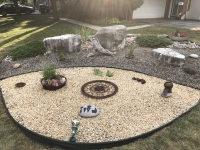You may have noticed this summer that we re-did the desert rock garden on our front yard. This garden was first set up in 2007. Our children still bemoan the fact that we chose the hottest time of that summer to do the work, and they were relegated to filling buckets with stones like some pediatric chain gang. I’m not sure that they didn’t place anonymous calls to Children’s Aid. But it has been a beautiful addition to our property. We planted two clumps of Japanese Blood Grass in the garden. Imperata cylindrica. For 11 years this grass behaved itself and was a welcome member of our garden family. Then things changed. The grass was no longer red, and it was no longer a clump. This attractive accent suddenly spread itself out through the entire garden. It was everywhere. You could pull it up but it would grow right back.
This spring we covered the garden with a tarp, in an effort to kill off the Japanese Blood Grass. We eventually took a shovel and pick axe to the garden, only to find that the grass had been spreading through the root system, and it was everywhere! We dug up all the roots we could see and left it fallow for a while. In time, the little bits of roots we had missed still brought up some shoots!
We had created this garden with a lot of zeal and planning. Unfortunately we didn’t include a lot of advice from experts. We had used black garden cloth to keep weeds from growing and we had planted our two clumps of the Japanese Blood Grass. We hadn’t realized that this particular grass spreads by the roots and it is incredibly invasive. We also hadn’t realized that the roots would travel along under the black garden cloth, like a highway. The garden cloth masked the problem for a good number of years, until it didn’t hide it anymore and the grass sprouted all over the garden. At this point there was nothing to do but rip out the whole garden and start fresh.
As I painstakingly removed bits of root from the garden, it made me think about how we can use things like black garden cloth in our lives. We think we are doing a good thing that is helping us, but we are actually masking a bigger problem and not getting to the root. We can allow problems to spread, undetected. Some pain killers and medications we take will temporarily mask symptoms, allowing the underlying cause to persist and worsen. Some behaviours do this, burying problems and using avoidance strategies to ignore and not deal with challenges in our lives. When we don’t get to the root, the problem will pop up again, just like our Japanese Blood Grass.
As you can see by the picture, we did plant Japanese Blood grass again in our new garden. We like how it looks! But this time we talked to some experts. We planted the clumps of grass in pots that would contain the root systems and stop them from spreading. We used garden cloth again, but we hope it doesn’t mask the underlying condition of the garden. We hope it does its job and protects foreign seeds from invading and planting themselves. As I think of the garden cloth, it reminds me that what might be intended for good can cover up an underlying problem. It is always important to get to the root, not mask a symptom, because the mask can’t last forever!

